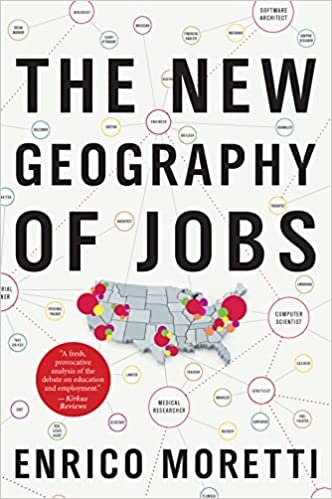Is the Charlotte region a ‘brain hub’ like Raleigh-Durham?

The Charlotte region is a banking hub, an air travel hub, even a sports hub — but is it a “brain hub”? That’s the most important question local policymakers will find themselves asking after reading Enrico Moretti’s The New Geography of Jobs. Brain hubs enjoy disproportionate prosperity and opportunity, and the gap between them and other cities and regions will only widen. Raleigh-Durham is, according to his findings, a brain hub.
But the Charlotte region…?
 The New Geography of Jobs Enrico Moretti Houghton Mifflin Harcourt 249 pages |
Moretti is an economist at the University of California, Berkeley. His work focuses on labor economics and urban economics. In The New Geography of Jobs, Moretti explores research at the intersection of those two subfields to understand the dynamics underlying current and future trends of economic growth.
Moretti’s book has been a big deal. Barack Obama blurbed it; Google Scholar counts more than 2,000 citations to it. It significantly affected the practice of economic development–directly by influencing its readers and indirectly by shaping the conversation around sectors and hubs of innovation. The book is definitely worth reviewing if you have never read it and it’s worth revisiting if you read it when it came out ten years ago.
He begins by describing a “Great Divergence” in the fortunes of cities. At one extreme are the prosperous brain hubs with highly educated workforces and prominent innovation sectors. At the other extreme are declining cities–often places where once-vibrant economies were built on manufacturing and the blue-collar jobs associated with it. The differences between such places are already stark, but Moretti calls this a “divergence” because the gaps are widening–perhaps at an accelerating rate.
Moretti finds that globalization and technological advancement are the main drivers of the trend. These two forces have led to both the decline of manufacturing and the rise of innovation. For Moretti, manufacturing–even small-scale, local, artisan, “manufacturing hipsters” making fancy chocolate or near-custom jeans–will not be a driver of economic growth for the foreseeable future. Such jobs will resemble other service jobs. Productivity-enhancing industries (which are key for the creation of wealth) are to be found elsewhere.
Moretti never clearly defines innovation. He says that the innovation sector can include a wide variety of goods and services. The key output of innovators, he writes, is that “they create things the world has never seen before.” In another part of the book, Moretti says, “[w]hat really matters is that American workers produce goods or services that are innovative and unique and not easily reproduced.” This innovation (whatever it is) is important because it increases productivity more than non-innovative work, which leads to more overall income.
The economies of brain hubs do not exclusively compromise innovation jobs, of course. They still have many service jobs. But the innovation sector is responsible for the prosperity and growth of the economy.
Unfortunately, becoming a brain hub is not as easy as embracing innovation. Moretti identifies powerful forces that work to reinforce regions’ particular advantages or disadvantages–forces that work to make the rich richer and the poor poorer. Innovation industries benefit from “agglomeration economies.”
In agglomeration economies, companies and workers are more productive when there are more companies and workers from the same industry around. Google works more effectively because it is in Silicon Valley, surrounded by other technology companies and countless software engineers, than it would in the Charlotte region, with its comparatively fewer tech companies and workers.
[Read more: Arbitrary Lines and the case for killing all zoning]
These effects are thought to be the result of “knowledge spillovers” between workers. In other words, people in the same industry regularly bump into each other–professionally and personally, planned and unplanned–and share ideas and discoveries. This collaborative churn generates new practices, new products, new companies, sometimes new industries. This is innovation and it is the key to success in the contemporary economy.
While Moretti offers a convincing account of how and why we got to where we are, his analysis does not provide a lot of guidance for more successful economic development. The best way to achieve a regional goal of getting richer is to be rich already. Absent that, his recommendation seems to be to cultivate the growth of specific productivity-boosting innovation sectors or clusters and to, more generally, grow or attract a highly educated workforce.
Moretti offers less advice for specific regions and more for the country as a whole. He argues that the U.S. is underinvesting in research and human capital. With respect to research, Moretti argues that the positive spillovers or externalities from research mean that private actors will underinvest in it. Accordingly, there is an important role for the government (especially the federal government) to play in funding research.
When it comes to human capital, Moretti offers two possible solutions. For one, the U.S. could invest more in education. Though college is expensive, the economic returns to higher education remain high, so Moretti would like to see more support for students pursuing degrees. In addition, he argues that the quality of math instruction in the U.S. needs to improve. As an alternative, Moretti says that the U.S. could admit more highly educated immigrants.
[Survey sheds light on the future of Charlotte’s creative community]
Moretti describes the country as at a “crossroads,” writing that “we need to decide which America we want as our future–the America of ever-increasing educational levels, rising productivity, and pragmatic optimism, or the America of deteriorating skills, shrinking horizons, and paralyzing pessimism.”
Like all research, Moretti’s work can be misinterpreted and misused. A quick summary of the book (like this review) will emphasize the importance Moretti assigns “innovation,” “research” and “human capital.” Policymakers may then, correctly, focus on economic development projects that claim to align with such priorities. But the essential challenge is to correctly identify those initiatives that genuinely promote those values.
It’s easy to say “innovation,” and if local governments advertise their interest in developing an innovation sector–interest that comes in the form of financial incentives–they will attract opportunists. In the language of political economy, this is called “rent-seeking” behavior, where actors waste their efforts on securing an existing prize (in this case, a financial incentive) rather than creating something new and valuable. That is, they will claim to be innovators without actually being innovators.
Local policymakers eager to establish this region as one of Moretti’s brain hubs must work hard to discern worthwhile projects from those whose rent-seeking promoters incant magic words like “innovation” or “research” in the hope of unlocking treasure. Such a practice requires constant vigilance and skepticism, including asking uncomfortable questions that may not flatter our regional pretensions–questions like “why would an industry-transforming innovation company want to locate here instead of in a region where the industry is more established and the company can benefit from agglomeration economies?”
A commitment to such rigorous critical thinking will only help the Charlotte region in its efforts to become a genuine brain hub.
[Editor’s note: The Urban Institute’s new Director of Regional Policy, Dr. Aaron Houck, reviews books about policy questions relevant to the Charlotte region from time to time. If you have comments or suggestions, you can reach him at aaron.houck@charlotte.edu]